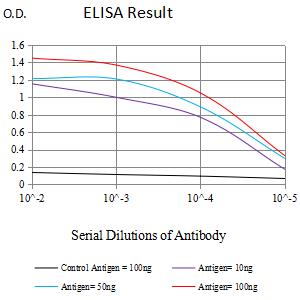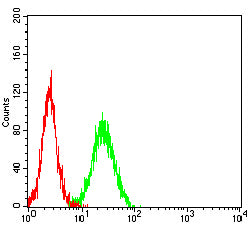

| WB | 咨询技术 | Human,Mouse,Rat |
| IF | 咨询技术 | Human,Mouse,Rat |
| IHC | 1/100-1/200 | Human,Mouse,Rat |
| ICC | 技术咨询 | Human,Mouse,Rat |
| FCM | 咨询技术 | Human,Mouse,Rat |
| Elisa | 咨询技术 | Human,Mouse,Rat |
| Entrez GeneID | 3693 |
| clone | 1A4H1 |
| WB Predicted band size | 88kDa |
| Host/Isotype | Mouse IgG1 |
| Antibody Type | Primary antibody |
| Storage | Store at 4°C short term. Aliquot and store at -20°C long term. Avoid freeze/thaw cycles. |
| Species Reactivity | Human |
| Immunogen | Purified recombinant fragment of human ITGB5 (AA: extra 50-319) expressed in E. Coli. |
| Formulation | Purified antibody in PBS with 0.05% sodium azide |
+ +
以下是关于SMCHD1抗体的3篇参考文献及其简要信息:
---
1. **文献名称**:*SMCHD1 is essential for X chromosome inactivation and binds the X-inactivation center*
**作者**:Blewitt ME, et al.
**摘要内容**:该研究首次揭示了SMCHD1在X染色体失活中的关键作用。作者通过免疫沉淀和Western blot技术,使用特异性SMCHD1抗体证实其与X失活中心(XIC)的结合,表明SMCHD1通过调控染色质结构参与表观遗传沉默。
---
2. **文献名称**:*SMCHD1 mutations associated with a novel muscular dystrophy pathway*
**作者**:Lemmers RJLF, et al.
**摘要内容**:本文发现SMCHD1基因突变与面肩肱型肌营养不良症(FSHD)相关。研究利用SMCHD1抗体进行免疫荧光染色和蛋白质印迹分析,证明突变导致SMCHD1蛋白稳定性降低,进而影响染色质压缩和疾病表型。
---
3. **文献名称**:*Epigenetic regulation by the SMCHD1 protein involves chromatin loop formation*
**作者**:Wang CY, et al.
**摘要内容**:该研究通过ChIP-seq和3C染色质构象分析,结合SMCHD1抗体的应用,揭示了SMCHD1通过介导染色质远程相互作用调控基因簇(如Hox基因)的沉默,为理解其三维基因组调控机制提供了证据。
---
**备注**:若需具体文献链接或补充信息,可进一步提供DOI或PMID进行检索。
SMCHD1 (Structural Maintenance of Chromosomes Hinge Domain-containing protein 1) is an epigenetic regulator critical for maintaining chromatin architecture and gene silencing, particularly in X-chromosome inactivation and genomic imprinting. Discovered in 2008. SMCHD1 belongs to the SMC protein family but differs from canonical SMC complexes by functioning as a monomer. It contains a conserved hinge domain essential for its chromatin-clamping activity, enabling long-range chromatin interactions and repression of gene clusters.
SMCHD1 antibodies are vital tools for studying its role in developmental disorders and diseases. Mutations in SMCHD1 are linked to facioscapulohumeral muscular dystrophy (FSHD) type 2 and Bosma arhinia microphthalmia syndrome (BAMS). In FSHD2. SMCHD1 dysfunction synergizes with DUX4 expression to cause muscle degeneration, while BAMS mutations disrupt craniofacial development. Researchers use SMCHD1 antibodies in techniques like Western blotting, immunofluorescence, and chromatin immunoprecipitation (ChIP) to investigate its localization, protein interactions, and chromatin remodeling mechanisms.
Recent studies also explore SMCHD1 as a therapeutic target, leveraging antibodies to modulate its activity in epigenetic editing or small-molecule screens. Its dual role in gene silencing and disease pathogenesis continues to drive antibody development for both diagnostic and functional studies.
×